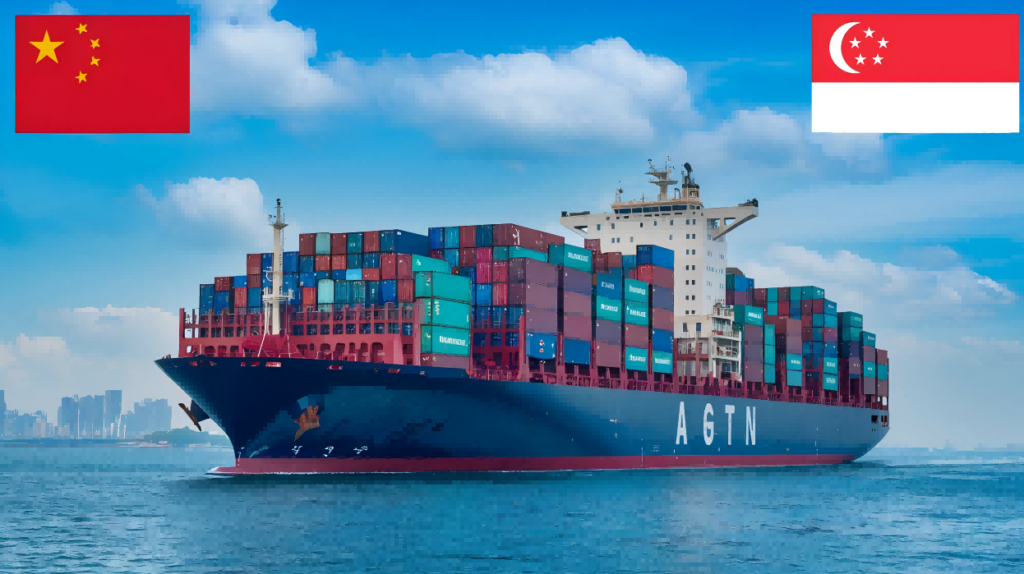- By TOP CHINA FREIGHT
- September 30, 2025
- Shipping
Table of Contents
Finding the cheapest freight forwarder China to Singapore is essential for companies aiming to reduce logistics expenses while maintaining reliable supply chains. Trade between China and Singapore continues to grow, with electronics, machinery, apparel, and consumer goods leading the flow. However, high freight costs, customs clearance challenges, and seasonal congestion remain common obstacles for importers. Choosing a forwarder that balances low costs with dependable service is the key to success. This guide explores cost factors, shipping methods, customs requirements, and strategies to secure the best deals.

What factors influence shipping costs from China to Singapore?
Freight costs vary due to multiple elements, and understanding them allows importers to plan smarter. Distance between China and Singapore is relatively short compared to trans-Pacific or Europe-bound trade, which helps keep costs down. Still, other aspects can drive expenses higher if not managed carefully.
1.Shipping mode:
Air freight is fastest but most expensive, while sea freight is cheapest but slower.
2.Cargo characteristics:
Weight, volume, and type of goods affect pricing. Heavy or oversized cargo can trigger surcharges.
3.Seasonality:
Rates rise sharply before Chinese New Year and peak retail seasons.
4.Fuel and surcharges:
Changes in bunker fuel prices directly impact sea freight charges.
5.Customs fees and tariffs:
Specific products may require import permits or attract higher duties.
Table: Cost Factors Overview
| Factor | Effect on Cost | Example |
|---|---|---|
| Shipping Mode | Air > Rail > Sea | Air may cost 5x more than sea freight |
| Cargo Weight & Volume | Higher load = lower per-unit rate | 20ft FCL cheaper per CBM than LCL |
| Seasonality | Rates increase during high demand | Pre-CNY sea freight up by 40% |
| Port & Handling Fees | Adds extra to base freight | Storage at Chinese ports increases costs |
| Customs Duties | Varies by HS code | Medical devices taxed differently |
How to select the cheapest freight forwarder China to Singapore?
Strong ties with carriers and port authorities ensure smoother operations.
Forwarders skilled in Singapore’s strict customs procedures reduce clearance delays.
Look for itemized quotations instead of bundled rates hiding hidden fees.
Cargo consolidation, warehousing, and packaging help cut overall logistics costs.
Real-time tracking improves planning and reduces costly disruptions.
What shipping methods are available from China to Singapore?
Three main methods connect China and Singapore: sea freight, air freight, and multimodal solutions. Each has different pricing, speed, and advantages.
Table: Shipping Methods Comparison
| Method | Average Transit Time | Cost Level | Best For | Pros | Cons |
|---|---|---|---|---|---|
| Sea Freight | 5–8 days | Low | Bulk, non-urgent goods | Cheapest, high capacity | Slower, possible congestion |
| Air Freight | 1–3 days | High | Urgent, perishable, high-value | Fast, reliable schedules | Expensive, limited cargo size |
| Rail + Sea | 12–16 days | Medium | Moderate volumes, cost-sensitive | Balanced cost and transit | Limited availability |
Most businesses rely on sea freight for affordability, but air freight is indispensable for urgent shipments.
Why sea freight is usually the cheapest option
Sea freight remains the preferred solution for most China–Singapore trade because it balances cost with reliability. The major Chinese ports—Shanghai, Ningbo, Shenzhen, Guangzhou—operate regular direct routes to Singapore’s busy terminals. This route efficiency lowers costs further.
FCL shipments:
Offer the best per-unit pricing when goods can fill a 20ft or 40ft container.
LCL shipments:
Allow small companies to ship partial loads cost-effectively, sharing space with other shippers.
Stable schedules:
High trade frequency ensures predictable routes.
However, sea freight requires planning. Importers should forecast demand early and book ahead to avoid delays and price spikes during peak seasons.
What customs documents are needed?

Proper documentation avoids costly delays at Singapore’s customs checkpoints. A professional forwarder assists with paperwork, but businesses must prepare key documents accurately.
Table: Customs Documentation Checklist
| Document | Purpose | Required By |
|---|---|---|
| Commercial Invoice | Declares value and product details | Customs |
| Packing List | Confirms shipment contents | Customs |
| Bill of Lading (B/L) | Proof of shipment and ownership | Carrier |
| Certificate of Origin | Confirms manufacturing source | Customs |
| Import Permits (if any) | Needed for restricted or controlled items | Authorities |
Errors in invoices or HS codes are common reasons for clearance delays. Partnering with an experienced forwarder reduces such risks.
How can consolidation save money?

For small and medium enterprises, Less than Container Load (LCL) consolidation is the most effective way to reduce costs. Forwarders combine shipments from multiple clients into one container, spreading costs across all parties.
Advantages include:
- Lower shipping expenses for small loads.
- Flexibility in shipment size.
- Frequent departures due to strong China–Singapore demand.
The main disadvantage is slightly longer transit times, as consolidation requires extra handling at warehouses. However, savings often outweigh this drawback for budget-conscious importers.
What challenges do importers face on this route?
Despite the short distance, importers face recurring obstacles:
1.Customs compliance:
Misclassification or missing permits delay clearance.
2.Peak season congestion:
Ports become overloaded before Chinese New Year, extending lead times.
3.Unexpected surcharges:
Carriers may impose congestion or emergency fees.
4.Inventory planning:
Balancing lower costs with longer sea freight transit remains difficult.
The cheapest freight forwarder China to Singapore doesn’t only quote low prices but also provides solutions for these problems, ensuring stable supply chains.
What strategies help reduce shipping costs?
Booking space weeks in advance avoids premium charges.
Filling a full container reduces per-unit cost.
Forwarders may lock in lower rates for regular clients.
Using efficient cartons reduces wasted space and dimensional weight.
Grouping multiple smaller shipments saves on handling fees.
Case Study: How a Singapore retailer cut shipping costs by 60%

A mid-sized electronics retailer in Singapore once depended heavily on air freight from Shenzhen to meet customer demand. While goods arrived quickly, high transport costs eroded margins. The company partnered with a forwarder offering sea freight consolidation.
By switching from weekly air shipments to bi-weekly LCL sea freight, the retailer reduced transportation expenses by 60%. Although delivery took an extra four days, customers accepted slightly longer lead times in exchange for lower product prices. The company reinvested the savings into marketing and inventory, doubling its sales within one year.
This example shows that the cheapest freight forwarder China to Singapore doesn’t always mean the fastest. Strategic planning with sea freight can transform overall business competitiveness.
Should businesses still use air freight?
Yes, air freight has a vital role despite its higher costs. It is best for:
- High-value products where speed outweighs expense.
- Urgent shipments such as medical supplies.
- Seasonal or trend-sensitive products like fashion items.
Air freight is reliable and reduces risks of damage. However, for most shipments, especially bulk cargo, sea freight is far more cost-effective. Businesses should weigh customer expectations against logistics costs when deciding.
Conclusion
Securing the cheapest freight forwarder China to Singapore involves more than comparing rates. True cost efficiency comes from optimized shipping methods, proper customs handling, consolidation strategies, and long-term planning. Sea freight remains the best option for most importers due to its affordability and capacity, while air freight serves urgent or high-value goods. Partnering with a reliable forwarder ensures smoother customs clearance, reduced risks, and lower overall costs. Ultimately, the right logistics partner strengthens competitiveness in Singapore’s dynamic market.
Need a Shipping Quote?
Click below to get a free, no-obligation quote from TJ China Freight.
We’ll respond within 24 hours with the best shipping options for your cargo.
FAQ
Q1:What is the cheapest option for small shipments?
LCL sea freight is usually cheapest for small cargo. Sharing container space reduces costs significantly compared to air freight or express courier services.
Q2:Do I need insurance for shipments from China to Singapore?
While not mandatory, insurance is highly recommended. It covers risks such as cargo damage, theft, or loss during transit, providing peace of mind.
Q3:How much does a 20ft container from China to Singapore cost?
Rates vary, but generally range from USD 600 to 1,000 depending on season, port of loading, and type of goods. Bulk contracts can reduce prices further.
Q4:What customs duties apply in Singapore?
Most goods attract GST at 8%. Some items like alcohol, tobacco, and motor vehicles are subject to additional excise duties. Consulting with a customs broker ensures compliance.
Q5:Can I track my shipment online?
Yes, many forwarders offer real-time tracking tools. These platforms provide updates on departure, transit, and arrival, allowing importers to plan inventory more accurately.



